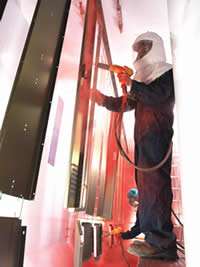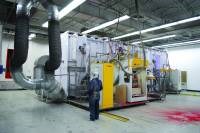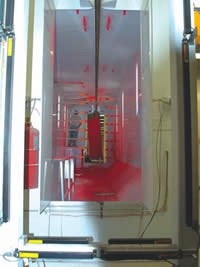Strong Finish
Powder coating makes lockers better
We’ve all used lockers, whether in school, at the gym or elsewhere. And most of us probably take them for granted.
Kevin Booth doesn’t. As the plant manager at Penco Products Inc.’s Salt Lake City, UT, facility, he’s responsible for production and quality of multiple locker product lines and configurations. The plant’s products are used not only in schools or gyms but in a variety of applications ranging from outdoor exposure at beaches and swimming pools to holding evidence in police stations.
Featured Content
“Our product is relatively simple to fabricate, but there are many variations in width, depth, number of doors, heights, vent patterns, shelving, latching mechanisms and hinge styles,” Booth explains. “And that’s just standard products. A typical order will have basic lockers in at least two or three different configurations. Then there will be filler panels, sloped tops, and other accessories. Every order is different.”
The variety continues in the plant’s finishing area, where Penco sprays 21 standard colors plus custom finishes. “Over the course of a year we spray upwards of 100 different colors,” Booth says. “Color change is a challenge we have always had to contend with. We average four or five color changes per shift, although there are days when we will spray 18 colors.”
Until 1999, the plant used liquid paint materials to finish lockers. When the plant expanded to its current size of 275,000 ft2, managers used the opportunity to upgrade the finishing line and switch from liquid paint to powder coating. “The big concern going into the switch was color change,” Booth says. “But, we soon discovered our finishing productivity was much higher than it was with liquid, despite the longer changeover times.”
According to Booth, the plant ran liquid and powder lines in tandem for a time, but quality and operating costs of the powder coat were so much better that managers ultimately phased out liquid altogether. In fact, finishing productivity was so good that the plant never installed phase two of a planned two-conveyor setup. “We’ve been able to improve productivity and output from the existing line so much that we don’t need two lines,” he says.
Penco’s Powder Process
Finishing at Penco begins with scheduling jobs on the line in the correct sequence based on color and when they need to ship. “We spray by order, so it’s a matter of managing the logistics of bringing everything together at the right time, and of grouping together colors to manage setups and color changes,” Booth says.
Complicating things on the finishing line are the hundreds of part numbers the plant sprays. But, as Booth explains, despite all the variations, lockers come in two basic styles, one that’s assembled on-site and one that’s welded.
The welded lockers offer the most potential for problems. “Obviously, getting powder coverage over all areas of a fully assembled welded locker, which can be up to 36 inches deep, can be a challenge,” Booth says. “Not only do you have the Faraday areas, but you also have a few areas where there are small gaps between panels.”
With the “knock-down” style lockers, which are assembled by workers at the building site, the door and frame assembly also offers a coverage challenge, although on a smaller scale. “The solution to both issues turned out to be an additional investment in a small powder booth placed just as parts exit the dry-off oven,” Booth explains. “The additional booth, along with a few powder coating techniques Penco has developed using heat to attract powder into tight corners, has eliminated rework and greatly improved the overall quality of Penco’s lockers and storage cabinets.”
Penco relies on multiple suppliers for powder materials. The plant’s primary powder technology is epoxy-polyester hybrid. The company also sprays anti-graffiti coatings for outdoor applications and anti-microbial materials. “One of the nice things about powder is, it enables you to offer customers a variety of finish options,” Booth says. “Our standard epoxy-polyester is good for low film builds, and our standard coating thickness is 1–1.2 mils. We also offer what we call Powder Coat Plus, which is a 2-mil film thickness.”
The vast majority of parts that run through the system are cold-rolled steel in thicknesses to 14-gage. A few components are fabricated from electrogalvanized. All receive a standard six-stage iron phosphate pretreatment consisting of an alkaline cleaner, rinse, phosphate, rinse, seal and DI water rinse.
“We’ve done quite a bit of work to coordinate the lubricants and fluids we use in our fabricating processes with our pretreatment system, so we know all the fluids we use are compatible,” Booth explains. “We also moved to a low-temperature cleaning chemistry last year that’s given us good results and saved quite a bit on our energy costs. The old cleaner ran at about 130°F, and this one runs just above ambient. We haven’t quantified the energy savings specific to the pretreatment process, but we do monitor natural gas usage monthly and every month this year we’ve been below the previous year’s cost.”
The pretreatment system is monitored closely, with multiple titrations, pH measurements and conductivity checks per shift. Additions are handled automatically, and monthly testing of soil loads in the tanks helps optimize maintenance schedules. “Soil load testing of process solutions enabled us to optimize maintenance frequencies and maintain quality without unnecessarily increasing costs by dumping too frequently,” Booth explains. “The more testing and monitoring you do, the better you know what’s going on, and the better you can run your operations.”
Penco is also using some low-temperature cure powders to further reduce energy costs, but is being very careful about making the switch to protect the corrosion performance of its products. “Salt-spray performance has always been very important to us, and we don’t want to impact that,” Booth explains. “When you’re getting 1,400 hr, you don’t do the testing overnight. That’s 60 days in the chamber. So we’re taking it slow, but our concerns about low-cure powders have been eased.”
Managers are evaluating powder formulations that would allow reduction of oven temperature from the current 370° to 325°F. “There’s always new technology in low-temp curing powders, but we’re still a little leery of some of the formulations that cure below 300°F,” Booth says. “They have some storage issues that we don’t want to get into right now.”
Pretreated parts run through a drying oven at 370°F before entering one of three powder booths, two automatics and one manual unit. “One of the automatic booths has 20 guns; the other has 22,” Booth explains. “Guns are on reciprocators and gun movers, so they can move in and out as well as vertically. We sense width as parts move into the booth, and we also detect how much of the spray envelope we’re using to turn guns on and off.
“Because of the number of colors we run, we have a lot of documentation on gun presets and other process parameters,” Booth continues. “We run everything from tans and creams to reds, oranges and yellows, so we have to adjust film thickness to get the hide we need. Then we have the regular coating and the thicker coating. So we have a lot of things we pay attention to.”
Developing spray process parameters is done using experience to “ballpark” settings and spraying some samples. “We check film thickness on the samples and make adjustments to get where we want to be,” Booth says. “We also do applied cost studies. In those, we process an order, measure the powder we used, and then calculate the area sprayed. We do that by color and vendor and develop history that way as well.”
Recipes include gun voltages and air flow settings, “and that’s pretty much it,” Booth says. “The rest of it is automatic. Guns also have compensation, so if we get a variation in target distance the guns automatically adjust.”
The automatic booths are 46 ft long, and typically one booth is on-line while the other is undergoing a color change. Changeovers begin with a gap in the line about equal to booth length. The entire booth is moved off-line for cleanup and preparation for the next color. “It used to take us 2 hr to change colors. Now we have that down to 45 min on our older booth and about 15 min on the newer model.”
The third booth is a small spray-to-waste manual booth that was originally installed because of concerns about coverage in welded lockers. “We don’t use it much for that,” Booth says. “More often it’s used for rework parts or very small part runs.”
Curing takes place in a convection oven with no IR boost. Ducting is on the floor, allowing heated air to do what it naturally does and evening out temperature variations over the oven height. “With other systems we always had problems curing our long parts,” Booth says. “We’d get quite a temperature differential from the top to the bottom of the oven. So floor ducting has worked very well and, since hot air wants to rise anyway it seems like a more natural flow.”
Penco does not collect waste heat from the oven but is in the process of investigating that and some other energy-saving measures. “For example, we have changed to low-e lighting.” Booth says. “We’ve gone to a variable-speed compressor system, and we make sure we do the basic things, like keeping loading dock doors closed in the winter.”
To assure quality, line operators use statistical process control techniques to track cured film thickness every 30 min. At the end of the line, parts get a final inspection that looks for paint appearance, color match, film thickness and overall product appearance.
Improvement Initiatives
Penco has employed some lean manufacturing principles in the plant for several years, focusing on minimizing material handling and work-in-process in fabricating operations. Equipment shuffling to enable more continuous work flows resulted in the company freeing up almost a third of its floor space. “Now we have what we call a Quick Ship program that we run right out of the plant, and it was made possible when floor space previously used by fabricating equipment was converted to warehouse space,” Booth says.
In the finishing department, lean efforts focus on general quality improvement, specific quality issues and, especially, increasing line density. “Right now, line density for most of our products is 50% or below,” Booth says. “One of the ways we can increase density is by changing the hang orientation of some parts.
“As we improve line density, we expect our application characteristics will improve in a couple of ways,” he continues. “First, hanging parts closer together will allow us to control the amount of powder wrap around the bottom of parts. We’ll get the wrap we want on the flange but a more consistent film thickness across the pane. We also expect to get improved first-pass transfer efficiency.”
Booth believes the plant could approach 80% line density with the techniques under development. “The real challenge then will be getting the parts on and off the line at 20 fpm,” he says. “We have some automation and some other ideas we’re looking at to make that happen.”





















